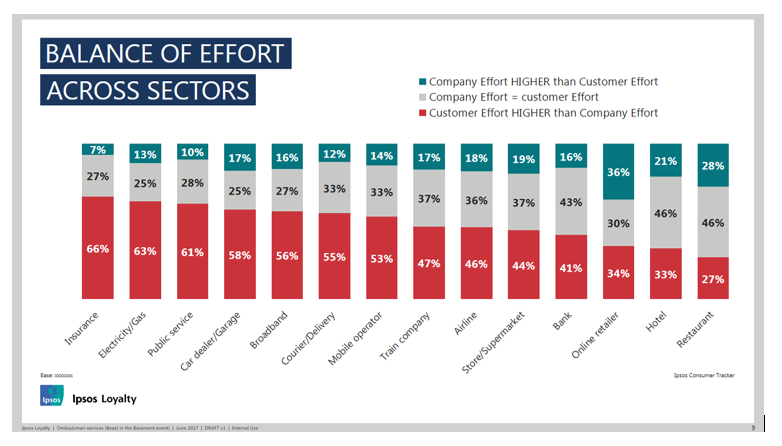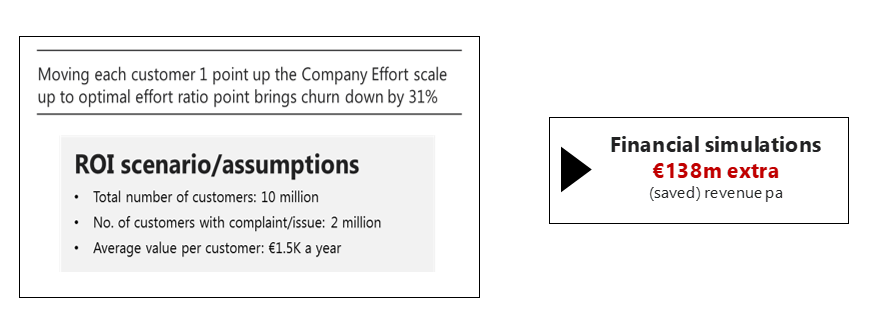Acknowledgement of customer experience as a driver of business performance is at an all-time high, with most companies making significant investments to meet their customers’ needs. But for many the question remains; how do you choose which customers or situations to prioritise? This article examines the options and wrestles with an intractable situation: Not all customer incidents are equal, so should you be fair to all of them?
When Ipsos introduced a new CX metric called the ‘Customer:Company Effort Ratio’ (C:CER), the response from the CX community signaled we had made a breakthrough. Extensive research showed it was three times better at predicting whether a customer would use a company again after a poor experience than the ‘Customer Effort score’ alone.
Now, our new research has further validated those findings and sheds light on why it is crucial for organisations to get the perceived balance of effort right.
Putting in the effort
To truly understand which customers are most likely to churn and when – and what to do to recover them if they do – organisations need to measure both perceived customer and company effort.
When things go wrong, customers are, to an extent, willing to put some energy in to get the situation resolved. However, when they believe that they are working harder than the company in question to solve an issue, customers feel unfairly treated. We know from social and behavioural science that ‘unfairness’ is an extremely potent ‘button’ that can trigger a ‘threat’ response in individuals. In the context of unfair treatment by companies, this can mean customers engaging in complaining behaviour, bad word-of-mouth, leaving scathing reviews on social media or simply stopping using the company entirely. Obviously, these all impact the financial health of the organisation in question.
Our data shows that when it comes to dealing with customer issues or complaints, the key for organisations is to reduce the perception of unfairness to lower or stop the ‘threat’ response and associated disloyal customer behaviour. And that’s all about getting the balance of effort right.
How serious is the threat?
In the UK, half of all customers believe they work harder than companies to resolve an issue. However, the ratio of effort varies significantly across sectors, with insurance, utilities and public services all registering more than 60% of customers who feel they work harder than companies. On the other hand, online retailers, hotels and restaurants all register far lower proportions (under 40%).

What’s at stake?
The balance here is critical – when customers perceive that they have had to put more effort than a company into sorting out a situation, they are:
- more than 4 times as likely to churn than if they feel companies have put more effort in than them
- 3 times as likely to share their negative experience on social media
- around twice as likely to tell friends and family about it

Customers who feel as though they work harder are also less forgiving. Our data indicates that the harder customers feel they work compared to companies, the less forgiving they become when a critical issue arises. This, of course, has significant implications when it comes to building long-lasting emotional engagement with customers.
Is there ROI in being fair to a customer?
Keeping all customers happy at all times is not a realistic goal for most organisations. A more viable proposition is to focus on either situations or customers that will provide the biggest return. Organisations need to design and deploy ‘smart’ interventions; interventions that are effective at mitigating negative customer outcomes, but also maximise the return on effort and investment.

Our data shows a non-linearity in the relationship between the balance of effort and churn rates. When it comes to reducing churn, the priority for companies should be to reduce the number of cases where customers feel they are working harder than them. In other words, focusing on reducing the ‘threat’ response and making it ‘fair’ again first makes sense, and will have the highest ROI.
And if making it fair to customers is not a powerful enough call to action, it is possible to demonstrate the financial return of doing so in order to drive a customer centric agenda all the way up to the management board of organisations. Under a few assumptions, it is possible to model the ROI of fairness in the context of service recovery by simulating increases in perceived Company Effort, like so:

How can you drive the perception of Company Effort?
So, the question remains, how can you illustrate to your customers that you are putting in the effort? When asked what they expect of companies when it comes to handling their issue, apart from resolving it, customers mention:
- being treated with respect – 56%
- receiving a detailed explanation – 50%
- being kept informed about situation – 39%
- an apology – 36%
- being offered financial compensation – 32%
These factors show that making it fair again is not just about delivering financial rewards. Companies can salvage negative experiences by being proactive, dedicated and transparent, and simply showing respect. The real challenge is to understand how to optimise interventions to maximise return on investment made in complaints and case management systems, and ultimately reduce churn and negative word-of-mouth.
Companies that react intelligently, use the vast amount of information at their disposal, and customise their responses based on the needs and expectations of individual customers will create opportunities to differentiate themselves and excel.
In increasingly competitive marketplaces, there are three key principles that must be observed to deploy an intelligent case management system:
- Focus on what really matters – companies need to prioritise incidents that have the highest impact on dissatisfaction and churn.
- Not all customers are equal – Incorporating customer profile and history into the mix is crucial. Focusing on high-value customers and those that are most likely to churn will provide greater ROI.
- There is no ‘one-size-fits-all’ intervention – different types of incidents may need different types of response. Different types of customers may need different types of response.
Customer experience management will always need planning. It’s a time-critical case of reacting intelligently, being mindful of your customer and knowing when it’s enough to just say ‘sorry’.
And perhaps more importantly, when it isn’t.



